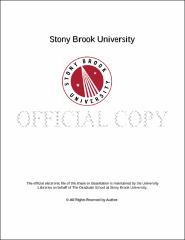| dc.identifier.uri | http://hdl.handle.net/1951/60210 | |
| dc.identifier.uri | http://hdl.handle.net/11401/71484 | |
| dc.description.sponsorship | This work is sponsored by the Stony Brook University Graduate School in compliance with the requirements for completion of degree. | en_US |
| dc.format | Monograph | |
| dc.format.medium | Electronic Resource | en_US |
| dc.language.iso | en_US | |
| dc.publisher | The Graduate School, Stony Brook University: Stony Brook, NY. | |
| dc.type | Dissertation | |
| dcterms.abstract | Intergroup encounters provide dramatic examples of cooperative behavior, in which unrelated individuals may coordinate aggression when mutual benefits arise from defending access to resources. While between-group competition over mates and resources are pivotal factors in theoretical models of the evolution of primate behavior, systematic study of these interactions has been limited due to the relative rarity of intergroup encounters and the logistical difficulties of studying multiple social groups simultaneously. Here I examine the nature and consequences of between-group competition in tufted capuchin monkeys (Cebus apella [Sapajus] nigritus) in Iguaz?? National Park, Argentina. I followed four neighboring groups, collecting explicit measures of the foraging and social contexts and consequences of intergroup aggression - through both naturalistic observations and field experiments. Within this population, males and females demonstrate concordant strategies during intergroup encounters, responding aggressively only in the presence of a high-quality food resource. Overall, males respond more strongly to the presence of neighboring groups, demonstrating no differences between dominant and subordinate males in either willingness to participate in or lead intergroup aggression. Females also participate, but they are less likely to lead aggressive encounters, allowing larger-bodied males to incur higher energetic costs and risk of potential injury. Collective defense by resident males allows groups to predictably win encounters against groups with fewer males, overcoming the potential benefits of a home-field advantage. Individuals appear able to assess the potential for winning an encounter and are more likely to participate during encounters against competitively weaker groups. When facing a competitively stronger group, most individuals flee, although females bearing the additional energetic burden of caring for a young infant appear more willing to attempt to maintain access to the resource, leading intergroup aggression despite a numerical disadvantage. Because dominant groups - those with more adult males - are better able to defend their core area, they share fewer of the resources within these areas, and individuals in dominant groups have higher per capita access to food, which may offset the costs of large group size. These results suggest the need to expand existing models of the evolution of intragroup social relationships to incorporate the potential for ecological variation and between-group contest competition over food resources to affect male-female relationships. | |
| dcterms.available | 2013-05-24T16:38:13Z | |
| dcterms.available | 2015-04-24T14:47:43Z | |
| dcterms.contributor | Doran-Sheehy, Diane M | en_US |
| dcterms.contributor | Janson, Charles H, Koenig, Andreas | en_US |
| dcterms.contributor | Watts, David P | en_US |
| dcterms.creator | Scarry, Clara JoAnn | |
| dcterms.dateAccepted | 2013-05-24T16:38:13Z | |
| dcterms.dateAccepted | 2015-04-24T14:47:43Z | |
| dcterms.dateSubmitted | 2013-05-24T16:38:13Z | |
| dcterms.dateSubmitted | 2015-04-24T14:47:43Z | |
| dcterms.description | Department of Anthropology | en_US |
| dcterms.extent | 148 pg. | en_US |
| dcterms.format | Application/PDF | en_US |
| dcterms.format | Monograph | |
| dcterms.identifier | http://hdl.handle.net/1951/60210 | |
| dcterms.identifier | http://hdl.handle.net/11401/71484 | |
| dcterms.issued | 2012-08-01 | |
| dcterms.language | en_US | |
| dcterms.provenance | Made available in DSpace on 2013-05-24T16:38:13Z (GMT). No. of bitstreams: 1
StonyBrookUniversityETDPageEmbargo_20130517082608_116839.pdf: 41286 bytes, checksum: 425a156df10bbe213bfdf4d175026e82 (MD5)
Previous issue date: 1 | en |
| dcterms.provenance | Made available in DSpace on 2015-04-24T14:47:43Z (GMT). No. of bitstreams: 3
StonyBrookUniversityETDPageEmbargo_20130517082608_116839.pdf.jpg: 1934 bytes, checksum: c116f0e1e7be19420106a88253e31f2e (MD5)
StonyBrookUniversityETDPageEmbargo_20130517082608_116839.pdf.txt: 336 bytes, checksum: 84c0f8f99f2b4ae66b3cc3ade09ad2e9 (MD5)
StonyBrookUniversityETDPageEmbargo_20130517082608_116839.pdf: 41286 bytes, checksum: 425a156df10bbe213bfdf4d175026e82 (MD5)
Previous issue date: 1 | en |
| dcterms.publisher | The Graduate School, Stony Brook University: Stony Brook, NY. | |
| dcterms.subject | Between-group contest | |
| dcterms.subject | Physical anthropology--Animal behavior--Ecology | |
| dcterms.title | The Functions and Consequences of Intergroup Aggression among Argentine Tufted Capuchin Monkeys (<italic>Cebus apella</italic> [<italic>Sapajus</italic>] <italic>nigritus</italic>) | |
| dcterms.type | Dissertation | |

